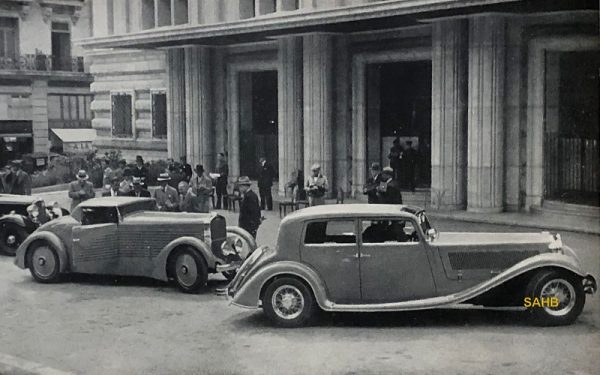
The 25th Monaco Concours d’Élégance was held on 5 April 1933. The judges assembled outside the newly built Sporting d’Hiver building. Our Snapshot shows two modern cars: in front is a Lancia Astura with four-door (possibly pillarless) body by Pinin Farina and behind it a dramatic one-off aerodynamic coupé by Albert Martin on a Delage chassis.
Lancia produced the Astura between 1931 and 1939. They replaced the Lambda with two models: the four-cylinder Artena and the larger, V8-powered Astura. Both models were introduced at the Paris Motor Show in 1931. Many fine coupés, convertibles and saloons were built on the Astura chassis by some of the top European coachbuilders, including Castagna, Boneschi and Pourtout in addition to Pinin Farina. The single-overhead-cam V8 engines, with a narrow-angle configuration in the tradition established in 1922 with the Lambda, started with a 19° angle and a capacity of 2606cc, producing 72 hp, and grew to a 17° 2973cc powerplant putting out 82 hp.
The Delage is almost certainly a D8, an eight-cylinder luxury car produced between 1929 and 1940. The coachbuilder, however, is a mystery. Albert Martin was an engineer who ran the Garage de l’Hippodrome – an establishment that appears to survive today as a Renault garage – in Mandelieu, just southwest of Cannes. This car was said to be the property of Mme Daviaud and won first prize in another concours at the Hôtel Martinez at Cannes, probably in the same year.
The Monaco event was as upmarket as they come. A report in Motor Italia pointed out that all the entrants, just over 50 in number, were from the gran classe – to the “absolute exclusion of utilitarian or middle-class models.” The list included a Letourneur et Marchand saloon on an Hispano-Suiza J12 chassis, a Swiss-registered Rolls-Royce Barker saloon, and a Renault Reinastella with coupé-limousine body by Binder.
The Sporting d’Hiver building was an appropriate venue for such a prestigious event. Completed in 1932, it was designed in the Beaux Arts architectural style and was used to host glamorous parties and exhibitions for the world’s high society. Sadly, by 1974 most society events had moved to the newly built Monte-Carlo Sporting in the Larvotto district and in 2008 Prince Albert II authorised its demolition. Despite significant opposition, the building came down in June 2015 and was replaced by a new building, designed in the postmodern style by Richard Rogers.







Leave a Comment